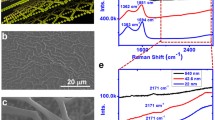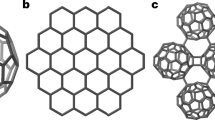Abstract
Thermally evaporated fullerene C60 porous films served as templates for a hybrid (molecular-inorganic) disordered blend formation. C60 films were covered with zinc oxide (ZnO) grown by atomic layer deposition. ZnO filled every pore in the C60 layer which led to the formation of C60–ZnO films with separate and distinguishable phases of C60 and ZnO constituents. Morphological, structural, optical, and electrical properties of the so-obtained films were investigated. Deposition of ZnO polycrystalline films on C60 porous layers resulted in the formation of ZnO with additional structural defects, compared to the films grown on planar substrates, which affected the electrical transport in the ZnO–C60 layers.






Similar content being viewed by others
References
Mitzi DB, Chondroudis K, Kagan CR (2001) Organic–inorganic electronics. IBM J Res Dev 45:29
Kagan CR, Mitzi DB, Dimitrakopoulos CD (1999) Organic-inorganic hybrid materials as semiconducting channels in thin-film field-effect transistors. Science 286:945
Lee BH, Yoon B, Abdulagatov AI, Hall RA, George SM (2013) Growth and properties of hybrid organic-inorganic metalcone films using molecular layer deposition techniques. Adv Funct Mater 23:532
Kim TW, Yang Y, Li F, Kwan WL (2012) Organic heterostructures in organic field-effect transistors. NPG Asia Mater 4:e18
Yu YY, Chen ChY, Chen WCh (2003) Synthesis and characterization of organic–inorganic hybrid thin films from poly(acrylic) and monodispersed colloidal silica. Polymer 44:593
Łuka G, Krajewski T, Szczerbakow A, Łusakowska E, Kopalko K, Guziewicz E, Wachnicki Ł, Szczepanik A, Godlewski M, Fidelus JD (2008) Hybrid organic/ZnO p-n junctions with n-type ZnO grown by atomic layer deposition. Acta Phys Pol A 114:1229
Lechmann MC, Koll D, Kessler D, Theato P, Tremel W, Gutmann JS (2010) Comparison of hybrid blends for solar cell application. Energies 3:301
Itaka K, Yamashiro M, Yamaguchi J, Haemori M, Yaginuma S, Matsumoto Y, Kondo M, Koinuma H (2006) High-mobility C60 field-effect transistors fabricated on molecular-wetting controlled substrates. Adv Mater 18:1713
Hinderhofer A, Gerlach A, Broch K, Hosokai T, Yonezawa K, Kato K, Kera S, Ueno N, Schreiber F (2013) Geometric and electronic structure of templated C60 on diindenoperylene thin films. J Phys Chem C 117:1053
Niinistö J, Putkonen M, Niinistö L, Song F, Williams P, Heys PN, Odedra R (2007) Atomic layer deposition of HfO2 thin films exploiting novel cyclopentadienyl precursors at high temperatures. Chem Mater 19:3319
Guo F, Yang B, Yuan Y, Xiao Z, Dong Q, Bi Y, Huang J (2012) A nanocomposite ultraviolet photodetector based on interfacial trap-controlled charge injection. Nat Nanotechnol 7:798
Yonehara H, Pac Ch (1992) Dark and photoconductivity behavior of C60 thin films sandwiched with metal electrodes. Appl Phys Lett 61:575
Reemts J, Kittel A (2007) Persistent photoconductivity in highly porous ZnO films. J Appl Phys 101:013709
Luth H (2001) Solid surfaces, interfaces and thin films. Springer, Heidelberg
Singh ThB, Sariciftci NS, Yang H, Yang L, Plochberger B, Sitter H (2007) Correlation of crystalline and structural properties of C60 thin films grown at various temperature with charge carrier mobility. Appl Phys Lett 90:213512
Yim S, Jones TS (2009) Growth dynamics of C60 thin films: effect of molecular structure. Appl Phys Lett 94:021911
Hayamizu S, Tabata H, Tanaka H, Kawai T (1996) Preparation of crystallized zinc oxide films on amorphous glass substrates by pulsed laser deposition. J Appl Phys 80:787
Luka G, Witkowski BS, Wachnicki L, Jakiela R, Virt IS, Andrzejczuk M, Lewandowska M, Godlewski M (2014) Electrical and mechanical stability of aluminum-doped ZnO films grown on flexible substrates by atomic layer deposition. Mater Sci Eng B 186:15
Cullity BD (1956) Elements of X-ray diffraction. Addison-Wesley Publishing Company Inc, Boston
Pearton SJ, Norton DP, Ip K, Heo YW, Steiner T (2005) Recent progress in processing and properties of ZnO. Prog Mater Sci 50:293
Pope M, Swenberg Ch (1999) Electronic processes in organic crystals and polymers. Oxford University Press, New York
Hofmann DM, Hofstaetter A, Leiter F, Zhou H, Henecker F, Meyer BK (2002) Hydrogen: a relevant shallow donor in zinc oxide. Phys Rev Lett 88:045504
Tam KH, Cheung CK, Leung YH, Djurii AB, Ling CC, Beling CD, Fung S, Kwok WM, Chan WK, Phillips DL, Ding L, Ge WK (2006) Defects in ZnO nanorods prepared by a hydrothermal method. J Phys Chem B 110:20865
Guziewicz E, Godlewski M, Wachnicki L, Krajewski TA, Luka G, Gieraltowska S, Jakiela R, Stonert A, Lisowski W, Krawczyk M, Sobczak JW, Jablonski A (2012) ALD grown zinc oxide with controllable electrical properties. Semicond Sci Technol 27:074011
Krajewski TA, Dybko K, Luka G, Guziewicz E, Nowakowski P, Witkowski BS, Jakiela R, Wachnicki L, Kaminska A, Suchocki A, Godlewski M (2014) Dominant shallow donors in zinc oxide layers obtained by low-temperature atomic layer deposition: electrical and optical investigations. Acta Mater 65:69
Ellmer K, Klein A, Rech B (eds) (2008) Transparent conductive zinc oxide. Springer, Heidelberg
Tynell T, Karppinen M (2014) Atomic layer deposition of ZnO: a review. Semicond Sci Technol 29:043001
Shklovskii BI, Efros AL (1984) Electronic properties of doped semiconductors. Springer, Heidelberg
Sato Y, Roh J-Y, Ikuhara Y (2013) Grain-boundary structural transformation induced by geometry and chemistry. Phys Rev B 87:140101(R)
Acknowledgements
The work was partially supported by the National Science Centre (NCN, Poland) under decision No. DEC-2012/07/D/ST3/02145. TEM investigations were supported by the National Centre for Research and Development (NCBR, Poland) under decision No. PBS1/A5/27/2012.
Author information
Authors and Affiliations
Corresponding author
Rights and permissions
About this article
Cite this article
Luka, G., Witkowski, B.S., Wachnicki, L. et al. Hybrid disordered blends formed from fullerene porous layers and zinc oxide grown by atomic layer deposition. J Mater Sci 50, 4132–4141 (2015). https://doi.org/10.1007/s10853-015-8970-8
Received:
Accepted:
Published:
Issue Date:
DOI: https://doi.org/10.1007/s10853-015-8970-8




